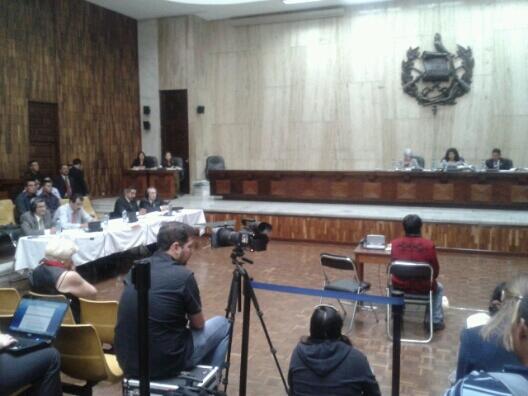Beisdes the coverage from the Open Society Justice Initiative, the Network in Solidarity with the People of Guatemala (NISGUA) is also filing reports and live tweeting from the genocide trial of former dictator Efraín Ríos Montt and ex-intelligence chief Mauricio Rodríguez Sánchez.
Here is an excerpt of NISGUA’s Day 3 report, along with some tweets from one witness’ testimony. You can read the entire report here.
Hours of intense first-person accounts of violence and endurance left impressions of profound grief: “They killed our fathers, our mothers, and everything we loved,” said one witness; as well as resolute purpose: “I am one of the few survivors. Perhaps I was sent to be the messenger of the story here.”
In all 12 witnesses were called to the stand to be questioned by lawyers for the prosecution and the accused. Most spoke with the aid of court-appointed Ixil Maya translators; one witness, Alberto López, was unable to deliver his testimony due to the lack of a K’iche’ Maya translator and will be given another opportunity to take the stand in a future hearing. Among the witnesses were leaders of the Association for Justice and Reconciliation, the survivors’ organization which first opened the genocide case more than a decade ago, including current AJR board member Domingo Raymundo Cobo and former board members Francisco Raymundo Chavez and Gaspár Velasco.
Echoed details in the survivors’ stories made clear the systematic nature of the Guatemalan military’s scorched earth campaigns, as one after another witness told of the soldiers’ extreme and indiscriminate cruelty; of the deliberate destruction of food, crops, animals, homes, and everything necessary for survival; of the violation of women’s bodies and traditional clothing. They also told of the conditions of internal displacement in “la montaña“, in the forests and hills of Quiché, as massacre survivors hid from army patrols and endured exposure and starvation. Gaspar Velasco said that he remained in the mountains from 1982 until the signing of the Peace Accords in 1996—”But there is still no peace,” he emphasized.
The defense of the accused Generals attempted to take advantage of these coinciding stories, with lawyer Francisco Palomo asking if one witness had been paid for his testimony, saying, “all the testimonies have said the same thing, did they take a class?” At another point, Palomo was quoted as having questioned a witness how much the blood of her husband was worth, before being stopped by an objection. The defense’s overall strategy seemed to focus on implying association between the witnesses and guerrilla forces.
Witnesses were questioned repeatedly as to whether they were members of the guerrilla or if they had seen or spoken with members of the guerrilla. As a commentator on Twitter pointed out, these are the exact questions that the population was subjected to in military interrogations during the 1980s. Again, the survivors were forced to repeatedly insist that their answers were truthful—but today it was the Generals who were on trial in a court of law, not frightened civilians in the sights of a soldier’s rifle.
Incredible endurance of survivors, unending trauma of memory, their sense of purpose in seeking justice and memorialization of loved ones.
— NISGUA (@NISGUA_Guate) March 21, 2013
Domingo: The soldiers stayed in Salquil Grande for 2 months, they ate all of our food. #GenocideGT #IxilesSpeak
— NISGUA (@NISGUA_Guate) March 21, 2013
Pérez: Domingo, what does this trial mean to you? Domingo: I am looking for justice for those responsible for the massacres. #GenocideGT
— NISGUA (@NISGUA_Guate) March 21, 2013
Domingo: We had to bury our families in the cornfields, not in the legal cemetery.
— NISGUA (@NISGUA_Guate) March 21, 2013
Domingo: When my father and my sister in law were killed, the soldiers cut off her skirt and left her naked. #IxilesSpeak
— NISGUA (@NISGUA_Guate) March 21, 2013
CALDH: How has this experience affected your life? Domingo: When my father died, I was all alone. No brothers, no sisters. I was very sad.
— NISGUA (@NISGUA_Guate) March 21, 2013
CALDH: Were you guerrilla? Domingo: No, we were workers. We grew crops. My father was guiltless when they killed him. Who ordered them?
— NISGUA (@NISGUA_Guate) March 21, 2013
Domingo: After the massacre, the soldiers said, “We killed the guerrilla.” But how can a little child carry a weapon?
— NISGUA (@NISGUA_Guate) March 21, 2013
Domingo: “One of my little brothers was hiding in the cornfield, crying. The soldiers came and cut his throat with a knife.” #IxilesSpeak
— NISGUA (@NISGUA_Guate) March 21, 2013
Domingo: At 6am, we were in our houses when soldiers came from the direction of Huehue. 30 people were killed. #IxilesSpeak
— NISGUA (@NISGUA_Guate) March 21, 2013




The Gnostics derived their http://633cash.com/Games leading doctrines and ideas from Plato and Philo, the Zend-avesta, the Kabbalah, and the Sacred books of India and Egypt; and http://633cash.com/Pengaturan” thus introduced http://633cash.com/Daftar into the bosom of Christianity the cosmological and theosophical speculations, which had formed the larger portion of the ancient religions of the Orient, http://www.cintaberita.com joined to those of the Egyptian, Greek, http://633cash.com/Promo and Jewish doctrines, which the Neo-Platonists had equally adopted in the Occident..It is admitted that the cradle http://633cash.com/Deposit of http://633cash.com/Withdraw Gnosticism is probably to be looked for in Syria http://633cash.com/Berita and even in Palestine. Most of its expounders wrote in that corrupted form of the Greek used by the Hellenistic Jews…and there was a striking http://633cash.com/Girl analogy between their doctrines and those of the Judeo-Egyptian Philo of Alexandria; itself the seat of three schools, at once philosophic and religious, the http://633cash.com/LivescoreGreek, the Egyptian, and the Jewish. Pythagoras and Plato, the most mystical of the Grecian philosophers (the latter heir to the doctrines of the former), and who had travelled, the latter in Egypt, and the former in Phoenicia, India, and Persia, also taught the esoteric doctrine…The dominant doctrines of Plutonism were found in Gnosticism